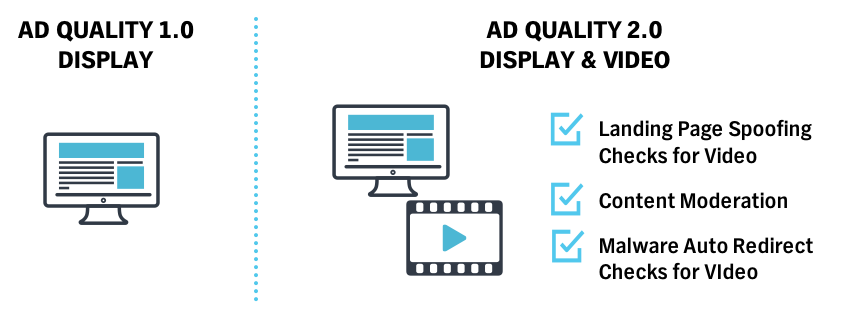Video revenue is a critical component in publisher monetization strategy, just as video advertising is an important medium for advertisers to reach their customers. Given video’s importance in the ad tech ecosystem as a whole, PubMatic has expanded our ad quality product suite to also cover video inventory.
The expanded coverage was necessary to deliver relevant ads and prevent an intrusive creative experience. Focusing on ad creative relevance allows us to block unwanted categories, advertisers and domains. In addition, by improving the user experience, we are able to effectively detect and block various security issues like malwares, forceful redirects and landing page spoofing.
Our overall goal in updating our ad quality suite is to produce new solutions which are accurate, fast, scalable, measurable and easy to integrate with existing products.
Solutions and Processes
Below is a brief overview of the solutions we developed to improve video ad quality:
- Ad Quality 2.0: Enriching Ad Quality for Video
We’ve extended our existing ad quality capability, originally meant for display ads, to also handle video creatives. To ensure a comprehensive solution , we’ve factored in new use cases to address the unique nature of video creatives.

Our new comprehensive solution automatically scans video ads for the following:
- Malware and auto-redirects
- Landing page spoofing
- Content moderation (i.e. suggestive content is classified and blocked automatically)
Our automated systems are complemented with a rigorous manual process to avoid false positives. Auto-classified creatives are manually reviewed on a daily basis to measure and assess automation accuracy. Outliers are further analysed as a feedback mechanism to improve automation and to uncover new unsupported cases.

Our solution updates presented some challenges. After updating our ad quality suite and building in additional checks we learned:
- Scanning can be more resource-intensive: To be committed to our SLA, we had to scale our ad quality (AQ) infrastructure to handle video scanning within a committed time. Scanning video is much more resource-intensive than scanning display ads. We had to add machines to handle the daily video traffic we had last quarter. Our team is currently working on an auto-scaling infrastructure to handle variations in video creative traffic.
- Manual review should be data driven: We don’t want to shortlist a random set of creatives for manual review. Rather, the shortlisting process needs to add value to the system so we can improve and establish confidence in the classification process. After brainstorming, we developed an algorithm which selected a configurable percentage of creatives from each classification bucket. For new buckets we kept the percentage a bit higher. The resulting false positive and negative rates helped us improve the accuracy of the system.
- Deduplication saves time: Although multiple video ad scripts may differ, they could still result in the same creative. Our effective deduplication technique helped us avoid duplicate scanning.
Key Learnings in Improving Video Ad Quality
- Failing quickly brings clarity: Doing individual proof-of-concepts (POCs) for multiple functions allowed us to try out multiple techniques in a very short time. This helped us fast-track the resulting development.
- Measurability is vital: We learned that when you are creating or building a classification system, always set aside time to develop measurability metrics. Measurability provides metrics to see how the system is improving or degrading over time.
- Robust unit and integration tests are a must: We often had to change our implementation based on new requirements and new cases. The time invested in robust unit and integration tests saved a lot of time.
- Build business data alerts: Don’t leave important business data unattended. Having alerts helped us react to issues more quickly.
What’s next?
Our teams are constantly working to improve our processes and provide the most efficient infrastructure possible for our clients. The updated solutions and processes detailed here help us improve our video ad quality. This benefits our partners and the digital ecosystem as a whole.
To learn more about what our engineering teams are doing, check out our recent content updates or apply to join us here.

